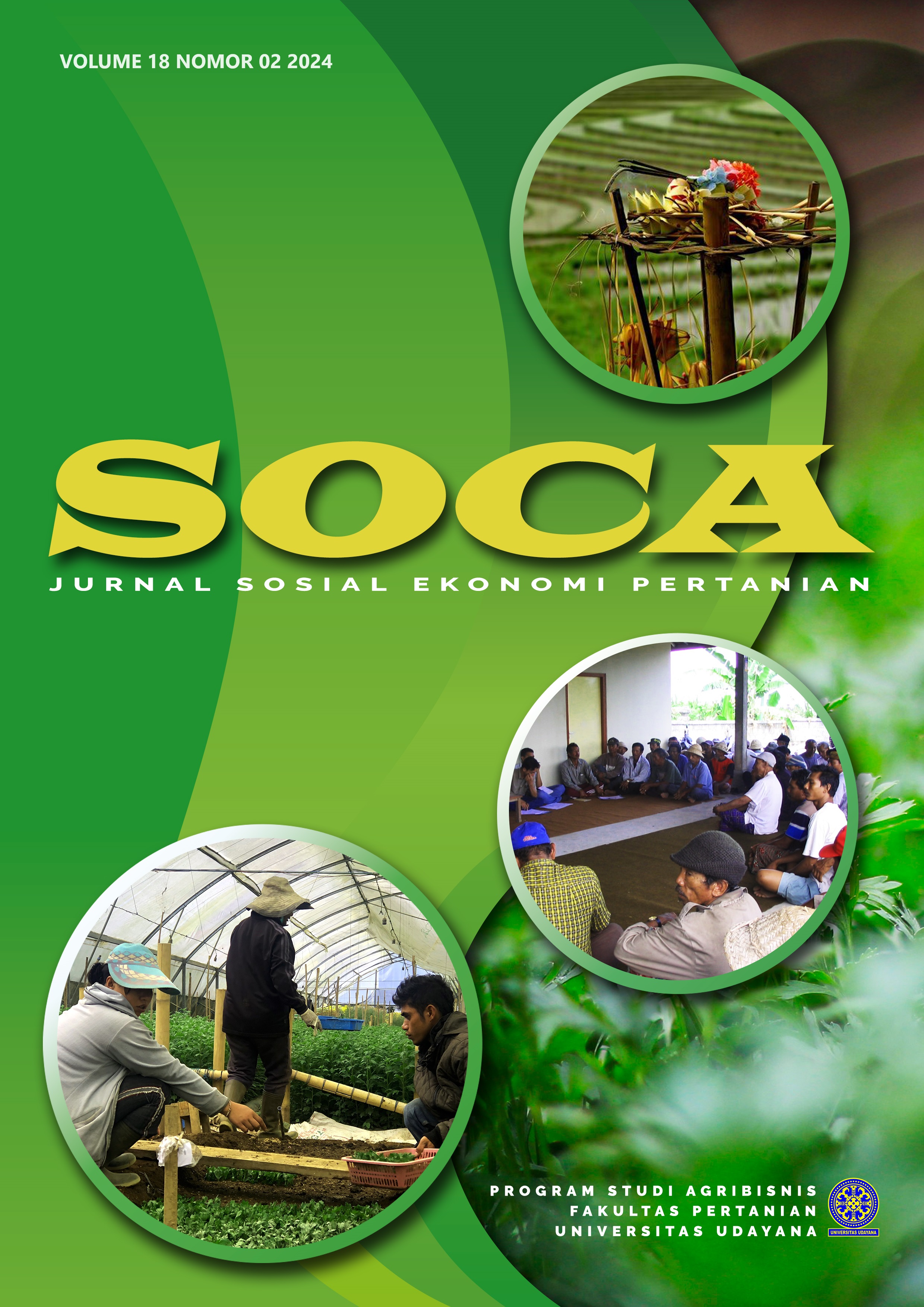Reduction of Economic Disparities in Regions with Different Population Densities through the Agricultural Sector
Abstract
Regions in Indonesia have relatively high economic growth, but are also accompanied with high economic inequality. In addition, population density tends to vary, so the opportunities to utilize resources by each population differ between regions. The objectives of this research are (1) to determine economic inequality in regions with high population density (Java-Bali), medium (Sumatra), and low (Maluku); and (2) to analyze the contribution of the agricultural sector in reducing this inequality. The Theil index analysis method is used to address the first objective, while the Theil index values with and without the agricultural sector are compared to address the second objective. The research results indicate that economic inequality in regions with high population density is higher than in regions with medium population density, and in regions with medium population density is higher than in regions with low population density. The research also confirms that the agricultural sector is able to reduce economic inequality in the research regions. The research findings are important as a basis for the development of the agricultural sector in order to reduce economic inequality
Downloads
References
Akita, T., & Alisjahbana, A. S. (2002). Regional income inequality in Indonesia and the initial impact of the economic crisis. Bulletin of Indonesian Economic Studies, 38(2), 201–222. https://doi.org/10.1080/000749102320145057
Akita, T., & Alisjahbana, A. S. (2023). The initial impacts of the covid-19 pandemic on regional economies in Indonesia: structural changes and regional income inequality. Sustainability (Switzerland), 15(18). https://doi.org/10.3390/su151813709
Akita, T., & Kataoka, M. (2022). Regional inequality and development: measurement and applications in Indonesia. Springer.
Ali, S., Mustafa, M. Q., & Shahbazi, I. A. (2013). Agriculture value added and income inequality in Pakistan: a time series analysis. Research Journal of Economics, Business, and ICT, 8(2), 25–33. https://ssrn.com/abstract=2424738
Alisjahbana, A., & Akita, T. (2020). Economic tertiarization and regional income inequality in a decentralized Indonesia: a bi-dimensional inequality decomposition analysis. Social Indicators Research, 151(1), 51–80. https://doi.org/10.1007/s11205-020-02374-z
Amri, K., & Nazamuddin. (2018). Is there causality relationship between economic growth and income inequality?: panel data evidence from Indonesia. Eurasian Journal of Economics and Finance, 6(2), 8–20. https://doi.org/10.15604/ejef.2018.06.02.002
Andiny, P., & Mandasari, P. (2017). Analisis pertumbuhan ekonomi dan kemiskinan terhadap ketimpangan di Provinsi Aceh. Jurnal Penelitian Ekonomi Akuntansi, 1(2), 196–210. https://doi.org/https://doi.org/10.33059/jensi.v1i2.412
Antara, M. (2022). Inequlity of Economic Development Between Districts in Bali Province. SOCA: Jurnal Sosial, Ekonomi Pertanian, 16(1), 74. https://doi.org/10.24843/soca.2022.v16.i01.p07
Aprelia, N. D. I., & Arif, M. (2023). Income inequality in East Java. Proceedings of the International Conference on Economics and Business Studies (ICOEBS-22-2), 563–579. https://doi.org/10.2991/978-94-6463-204-0_48
Artaningtyas, W. D., & Sriwinarti, A. (2020). The influence of fiscal decentralization, economic growth, and economic openness on the inter-provincial development disparity on Java 2001-2017. Eko-Regional: Jurnal Pembangunan Ekonomi Wilayah, 15(2), 100–115. https://doi.org/https://doi.org/10.20884/1.erjpe.2020.15.2.1380
Bouincha, M., & Karim, M. (2018). Income inequality and economic growth: an analysis using a panel data. International Journal of Economics and Finance, 10(5), 242. https://doi.org/10.5539/ijef.v10n5p242
Breau, S. (2015). Rising inequality in Canada: A regional perspective. Applied Geography, 61, 58–69. https://doi.org/10.1016/j.apgeog.2014.11.010
Chen, G., & Zhang, J. (2023). Regional Inequality in ASEAN Countries: evidence from an outer space perspective. Emerging Markets Finance and Trade, 59(3), 722–736. https://doi.org/10.1080/1540496X.2022.2119810
Cuong, N. V. (2010). Does agriculture help poverty and inequality reduction? evidence from Vietnam. Agricultural Economics Review , 11(1), 44–56. https://doi.org/10.22004/ag.econ.118576
Destiningsih, R., Sugiharti, Rr. R., & Achsa, A. (2019). Analysis of income disparities in Jambi province 2010-2017. AFEBI Economic and Finance Review (AEFR), 4(1), 51–60.
Francks, P., Boestel, J., & Hyop Kim, C. (2002). Agriculture and Economic Development in East Asia: From growth to protectionism in Japan, Korea and Taiwan. Routledge.
Gordón, I. G., & Resosudarmo, B. P. (2019). A sectoral growth-income inequality nexus in Indonesia. Regional Science Policy and Practice, 11(1), 123–139. https://doi.org/10.1111/rsp3.12125
Hakim, D. R., & Rosini, I. (2022). Regional income inequality in Indonesia: the role of public and private investment. Jurnal Ekonomi Malaysia, 56(3), 87–101. https://doi.org/10.17576/JEM-2022-5603-05
Khaerunnisa, N. O., & Puspitasari, I. F. (2024). Income inequality in West Java 2017–2021. Proceedings of the International Conference on Economics and Business Studies (ICOEBS-22-2), 580–593. https://doi.org/10.2991/978-94-6463-204-0_49
Milanovic, B. (2018). Towards an explanation of inequality in premodern societies: the role of colonies, urbanization, and high population density. Economic History Review, 71(4), 1029–1047. https://doi.org/https://doi.org/10.1111/ehr.12613
Muta’ali, L. (2019). Dinamika Peran Sektor Pertanian dalam Pembangunan Wilayah di Indonesia. Gadjah Mada University Press.
Novianti, T., & Panjaitan, D. V. (2022). Income inequality in Indonesia: before and during the covid-19 pandemic. International Journal of Economics and Financial Issues, 12(3), 29–37. https://doi.org/10.32479/ijefi.12996
Sa’diyah, S. H., & Irham. (2016). Peran sektor pertanian dalam mengurangi ketimpangan pendapatan di wilayah Papua sebelum dan sesudah otonomi khusus. Agro Ekonomi, 27(1), 1–18. https://doi.org/https://doi.org/10.22146/jae.30216
Seidman, K. F. (2005). Economic Development Finance. Sage PublicationSage Publication.
Suryani, K. G., & Woyanti, N. (2021). The effect of economic growth, hdi, district/city minimum wage and unemployment on inequity of income distribution in Province of D.I Yogyakarta (2010-2018). Media Ekonomi Dan Manajemen, 36(2), 170. https://doi.org/10.24856/mem.v36i2.1990
Walujadi, D., Indupurnahayu, I., & Endri, E. (2022). Determinants of income inequality among provinces: panel data evidence from Indonesia. Quality - Access to Success, 23(190), 243–250. https://doi.org/10.47750/QAS/23.190.26
Yan, X., & Mohd, S. (2023). Trends and causes of regional income inequality in China. Sustainability (Switzerland), 15(9). https://doi.org/10.3390/su15097673
Yuldashev, M., Khalikov, U., Nasriddinov, F., Ismailova, N., Kuldasheva, Z., & Ahmad, M. (2023). Impact of foreign direct investment on income inequality: Evidence from selected Asian economies. PLoS ONE, 18(2), 1–14. https://doi.org/10.1371/journal.pone.0281870













